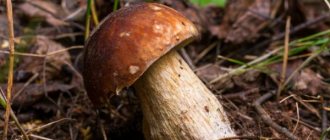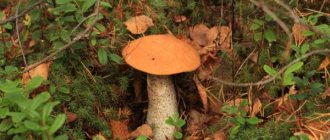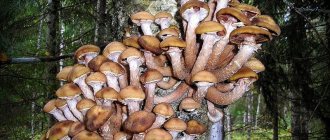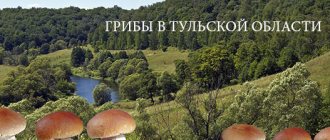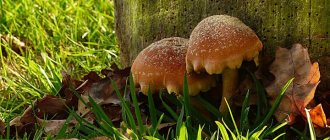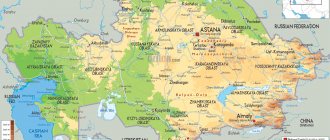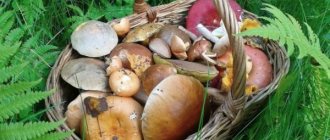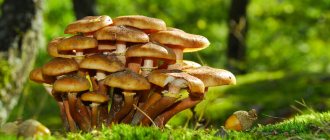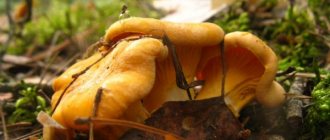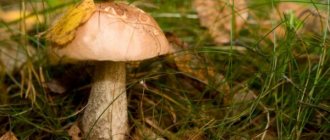| ✈✈✈ List of open countries during coronavirus. ✈✈✈ Where to go on vacation abroad ✈✈✈ |
8 266
In this post:
- Where and when to pick mushrooms.
- Edible species.
- Poisonous, non-edible mushrooms of Crimea.
Crimean flora and fauna are diverse and unique due to climatic conditions. Particular attention should be paid to the huge number of types of mushrooms. In total, there are more than 100 species on the peninsula. But before you go on a “silent hunt”, it’s worth figuring out where and what kind of mushrooms grow.
Where to pick mushrooms in Crimea
There are a lot of mushroom places in Crimea. Forest hotels can be found both in the mountains of the peninsula and in the steppe zone. In October, in a young pine forest, in the mountains from the village of Stroganovka, it was possible to collect “butterfly”, and now in this place they are collecting “butterfly” or gray row.
Many connoisseurs of quiet hunting are attracted by the Crimean Mountains. Here, at altitudes of 300–700 meters, you can collect significant prey. Rich in mushrooms and yayla - the flat tops of mountain ranges. Many mushroom pickers have heard about Ai-Petrinskaya Yayla. Another mushroom place in Crimea is the outskirts of Sevastopol, where the forest stretches towards Bakhchisarai. In the east of the peninsula you can wander through the forests from Old Crimea to Feodosia.
Material on the topic: Chanterelle mushroom: where and how to collect it correctly.
But not only forests are of interest to mushroom pickers. The steppes can also present a pleasant surprise. Some types of mushrooms can be collected in the fields around the Donuzlav and Sasyk estuaries. In addition, forests in Luchistoye and the area of Mount Demerdzhi are considered good mushroom places.
They also find mushroom places near Sevastopol, where the forest stretches towards Bakhchisarai. In the eastern part of the peninsula, mushrooms can be collected in forests from Feodosia to Old Crimea. According to Simferopol mushroom pickers, most of the “mice” grow in the forest in the village of Kolchugino and in the area of the Crimean Astrophysical Observatory, boletus - in Zelenogorskoe and Stroganovka, saffron milk caps - near Rybachye, chanterelles can be found in Mramornye.
Map of mushroom places
There are several main mushroom places where you should go on a “quiet hunt”. To begin collecting edible specimens, you need to explore possible locations. The determinant in this case is a special atlas.
- Kolchugino village: here you can find chanterelles, milk mushrooms and gray rowers (mice).
- Belogorsky district: they collect fiber here.
- Simferopol region: boletus, govorushka and saffron milk caps predominate.
- Bakhchisarai region: mice and champignons are collected.
Honey fungus grows everywhere in Crimea (from mid-summer to November). Near Ai-Petri there are common boletus. On the southern coast of Crimea, from May to October, purple moth and raincoats are found.
Crane mushrooms grow on the territory of the Crimean steppes, and honey mushrooms and porcini mushrooms are found in old Sevastopol. Near the Kherson region, oyster mushrooms, talkers and trumpet chanterelles are found.
What to collect in Crimea
In Crimea you can find quite rare species of mushrooms. But, nevertheless, among those especially loved by Crimeans are several varieties characteristic of this region.
Saffron milk caps
The time for these mushrooms usually occurs in Indian summer. They grow in forests until mid-October. If the weather is good, they can be collected until December. Ryzhik loves mixed forest (oak and pine), shady places under pine and spruce trees, longitudinal grooves, holes and ravines. It's very easy to recognize him. The mushroom cap is usually up to 15 centimeters in diameter. It is almost flat, but can sometimes be depressed in the middle, with the edges turned down. Later the cap straightens and becomes funnel-shaped. Its color is red, light orange, reddish or bluish green. The skin is smooth, moist and sticky. The leg is usually up to 9 centimeters long.
Mushroom can be prepared in all possible ways. In any case, it will turn out very tasty. In Europe it is generally considered a delicacy. It is very nutritious, but at the same time easily digestible.
Salted saffron milk caps are especially good. Their peculiarity is that they do not require spices. And you can eat them the very next day after salting. You can eat these mushrooms right in nature. Just chop them finely and sprinkle with salt - within an hour you will have a wonderful snack at your disposal.
Honey mushrooms
In the wet and warm autumn, honey mushrooms are collected in Crimean forests, gardens and orchards literally in buckets. The mushroom cap is 3–10 centimeters in diameter, and the stem is very long and often reaches 15 or even 20 centimeters. The cap is grayish-yellowish with dark scales on top, lamellar and white below. The mushroom often grows in groups on stumps, hence its name. Loves fallen trees, sometimes grows in the foundations of living ones.
There is no consensus on the taste qualities of this mushroom. For example, it is not popular in the West. There it is considered of little value, and sometimes even inedible. In our area, honey fungus is one of the most beloved mushrooms among the population. But it is worth remembering that honey mushrooms cannot be eaten raw. Even a slightly undercooked mushroom can cause digestive upset.
How honey mushrooms grow.
Butter
For them, go to the Ai-Petri plateau. This is a real Mecca for all butter connoisseurs. The diameter of the cap of this mushroom can range from 3 to 14 centimeters. It initially has a hemispherical and then simply round shape. The skin color is brown and can take on a variety of shades. The leg is from 3 to 11 centimeters long. The mushroom grows in forests and prefers bright places, such as clearings and forest edges. Sometimes it can be found in the meadow under a tree. In Crimea, boletus often grows around stones.
In summer, at the beginning of the season, most mushrooms are eaten away by insects. But as autumn approaches, the situation improves. Butterflies are loved all over the world. The most delicious mushroom is considered to be salted and pickled. Then this is practically a gourmet dish. But it is worth remembering that boletus can cause allergies in some people.
Butter mushrooms.
Gray row (mice)
Perhaps the most popular mushroom in Crimea. The cap is usually with a diameter of 4 to 12 centimeters, round-conical, gray in color. The leg is very long - from 8 to 12 centimeters, but it is often immersed in moss. In most cases, the mushrooms are very small. But there are also real giants.
The mushroom grows from mid-September to November. It is collected in coniferous and mixed forests. Mice can be found near middle-aged pines, on sandy soil, in moss and under fallen leaves and pine needles. Many consider the gray row to be a very tasty mushroom. You can cook in all possible ways.
The row is gray.
Chanterelles
Chanterelles are adored by mushroom pickers for their beauty and perky appearance. These are mushrooms with a cap that turns downward, forming one whole with the stem of the mushroom. The hat seems to be pressed down in the center. Rib-like plates stretch from the cap to the stem. The stem of the mushroom narrows as it passes through the roots. They are red, light orange, and in some places even white in color.
They grow mainly in groups. They love wooded areas. Grows in shady places. Chanterelles can be collected from May to November. In Crimea, they are found near the village of Mramornoe, Simferopol region. Chanterelles fried in sour cream or with potatoes are a favorite childhood dish of many Russians. They can also be canned and used in soups.
Mountain white mushroom
Mountain porcini mushroom is a favorite of Crimean mushroom pickers. These are white mushrooms with a cone-shaped cap with an uneven edge and bends. The uniqueness of this type of mushroom lies in its ability to produce an antibiotic that can destroy tuberculosis bacilli. It grows in different areas of Crimea, both in the mountains and in the steppes, and is also found in deciduous forests. The period for collecting mountain porcini mushrooms begins in April and lasts until September. It grows in groups and fills fairly large areas. In the preparation of these healthy mushrooms, the preferred method is drying and canning; they can also be consumed freshly prepared.
Mountain white mushroom.
Milk mushrooms
Mushroom pickers come across mushroom pickers in mixed forests in the summer. Rarely found in the foothills and mountainous regions of Crimea. The main harvest season is July and September. Active growth begins after heavy rains. There are no real milk mushrooms in Crimea, but oak, pepper and dry milk mushrooms grow. Pepper milkweed can be distinguished by its funnel-shaped white cap with grayish spots. On its narrow plates drops of milky juice are noticeable, which tastes very bitter. The leg is short, narrowed below. You can eat the mushroom after repeated soaking.
The dry milk mushroom also has a white cap, but with brown spots. The plates have a bluish color. The bitter juice does not appear after breaking. The mushroom is ideal for pickling and pickling (after pre-soaking).
In the mountainous part of Crimea you can find oak milk mushrooms. These reddish lamellar mushrooms grow in deciduous forests. Brown stripes are easily visible on their caps. Legs with yellow pits lose their density as they grow. Suitable for marinating, frying, boiling.
What do milk mushrooms look like?
Raincoats
This mushroom belongs to the champignon family. In Crimea it can be found in deciduous forests. There are three types of puffball: prickly (the surface is covered with soft small spines), pear-shaped (looks like a pear, covered with a rough, thin-lumpy skin) and giant puffball - it can grow up to 34 centimeters in height. In a number of Western European countries, puffball mushrooms are considered a delicacy. Most types of puffballs are edible, but there are also inedible types that can easily be poisoned if you do not have basic knowledge.
There are several main signs that a mushroom is edible. The most important of them is the presence of white flesh without any shades; it must be dense and firm. Another important sign is that the inner pulp of the mushroom should be of a uniform consistency. Puffballs differ from ordinary mushrooms in that they do not have a long stem, plate, cap, etc.
Material on the topic: How and when to collect raincoat mushroom.
Mice (gray row)
There are several types of rows that can be eaten. But they are quite difficult to distinguish from inedible ones. More often, mice are found in coniferous and mixed forests, in moss or on sandy soil. Rows can grow singly or in groups.
p, blockquote 12,0,0,0,0 –>
In Crimea they are found in early or mid-autumn. Experienced mushroom pickers go specifically for them to the forests near the village of Kolchugino or to the area of the Crimean Astrophysical Laboratory.
p, blockquote 13,0,0,0,0 –>
The hats of young mice (5-10 cm) have a conical shape with rolled edges. In mature rows it is flat, fleshy, with irregularities. The edges are unraveled and have small cracks. A small bump protrudes in the center. The plates in it are rare and widely spaced. The color of the cap is gray (from light to dark shade). After rain, it looks slimy and becomes slightly sticky, which causes leaves and small lumps of earth to stick to it, making it difficult to notice.
p, blockquote 14,0,0,0,0 –>
The stem of the row is dense, long (up to 12 mm), thickened at the base. In mature rows it becomes hollow inside. The color of the leg is pale yellow or grayish below. A plaque is visible next to the cap. The pulp of the mushroom has a dense but fragile structure with a faint powdery odor.
p, blockquote 15,0,0,0,0 –>
p, blockquote 16,0,0,0,0 –>
Mice can be salted, boiled, marinated. After boiling, they prefer to fry them and serve them as a tasty addition to main courses. Although they are very tasty in soups, casseroles, salads, and sauces.
p, blockquote 17,0,0,0,0 –>
Before cooking, they need to be sorted out, removing wormy mushrooms, dirt and pine needles. It is advisable to then soak for two hours in salted water with the addition of citric acid. If the mushrooms have a strong aroma, you can add a bay leaf or a couple of black peppercorns to the water to beat it off.
p, blockquote 18,0,0,0,0 –>
Tips for mushroom pickers
Mushroom pickers have their own ethics of behavior, consisting of simple but very useful rules. For example, there is no need to kick mushrooms that are not of interest to you. Perhaps someone else will rip them off. For mushrooms, a basket made of twigs is best suited, since plastic bags do not allow air to pass through and, as a result, your collected “harvest” may not make it home.
You cannot break off the stems of the mushroom along with the mycelium, just as you cannot tear the moss. Under the sun's rays, the open mycelium will dry out and die. The most favorable conditions for the appearance of mushrooms are warm rain. That is, if there was a light rain in the evening, then in the morning you can safely go on a quiet hunt. Attention, the most important rule! If you're not sure, don't take the mushroom. At any slightest suspicion, it is better to just leave him in the forest. After all, life is much more important than the “harvest”.
What can be collected in Crimea.
Chanterelles
Another name is cockerels. The lands of the Simferopol region are rich in them. There are many of them near the village of Mramornoe. Mushroom pickers also go to the forests of Belogorsk, Kirov, and Bakhchisarai regions.
p, blockquote 19,0,0,0,0 –>
Chanterelles grow in numerous groups in sunny places, in clearings or next to clearings. They are also found in moss, among birches, pines, and spruces. Appear from the beginning of June. You can collect all summer until the first autumn frosts.
p, blockquote 20,0,0,0,0 –>
A distinctive feature of the structure: the mushroom does not have a pronounced transition from the stem to the cap. Uniform color: yellow (shades vary from light to dark, almost orange).
p, blockquote 21,0,0,0,0 –>
The hat has an irregular shape with wavy, unfolded edges that form a depression in the center. But its surface is absolutely smooth. The leg tapers downwards, the length is about 5 cm. The flesh is fleshy, dense, with a slightly sour taste. When pressed, it acquires a reddish tint. The smell is weak.
p, blockquote 22,0,0,0,0 –>
It must be distinguished from the false chanterelle, whose cap has no bends and resembles small funnels. In addition, their color is always orange, closer to red. The yellow hedgehog also looks like a chanterelle. This is an edible yellow mushroom. It has a fleshier cap and a thicker white stalk.
Raincoats
Puffballs are mushrooms that cannot be poisoned. But when collecting them, you still need to check their flesh: in a real raincoat it is always white. Giant and pear-shaped raincoats are common in Crimea. The first has a fruit body that is round and white, but becomes yellowish over time. Can reach a height of 34 cm.
p, blockquote 43,0,0,0,0 –>
Also interesting to read: Poisonous mushrooms of Crimea
p, blockquote 44,0,0,0,0 –>
The fruiting body of the pear-shaped puffball is very similar in shape to a pear. The skin is rough with small tubercles. Raincoats grow in the foothills, choosing rotten wood for themselves.
p, blockquote 45,0,0,0,0 –>
Only young mushrooms are suitable for food. They are dried or fried. They also make a delicious mushroom soup. In terms of nutritional content they can be compared with white ones.
p, blockquote 46,0,0,0,0 –>
Greetings! While winter covers remote regions with its blanket of snow, we continue to collect mushrooms, and then dry them, freeze them, fry them, salt them and pickle them. In my article you will learn about what mushrooms grow in Crimea in autumn and early winter and how to pickle boletus; they grow everywhere and open the autumn season.
In the second half of November and early December, the weather in Crimea is unstable, which is considered the norm. Cold winds, bright sun, heavy rains, fog, sleet and temperatures from -5 to +15 - all this can be seen in one week.
Since September, Crimeans have been going out for “silent hunting” en masse. Butterflies, little mice, bitterlings, one-barrels, bluelegs, honey mushrooms, hygrophorus (cranes), saffron milk caps, umbrellas, hedgehog mushrooms, champignons, porcini mushrooms, cobweb mushrooms, oyster mushrooms and many other mushrooms are collected before the first frost.
You can see these starfishes or octopuses in December,
and mustards, which need to be soaked for several days.
The last boletus was collected at the end of November, but “advanced” mushroom pickers claim that there are still Bellini boletus.
And hygrophores are collected in December.
Hygrophorus or crane
Very tasty little mice, although they don’t look very edible.
Lilac-footed row (bluefoot)
Blueberries are fragrant and very tasty. Just wash them, boil for 15-20 minutes, and then stew in sour cream.
On December 13, the air temperature rose to +18°C, it rained in the mountainous areas, and a week later it became sharply cold, but even in the snowy forest, mushroom pickers collected: late hygrophorus and Lindtner, deer horns, hedgehogs and baby mice. In the photo, the harvest of a resident of Sevastopol was harvested on December 20.
There are many mushroom places, but not everyone likes to talk about them). I read this status in the VK group:
“I understood one thing, it’s better not to tell anyone anything about where to collect anything! There is nothing left of the forest. It’s terrible that everything has just been rummaged through. Every centimeter! People come with rakes and a mess begins!”
I agree, many in the forest behave like vandals, and this applies not only to mushroom picking.
Thanks to the diversity of natural zones in Crimea, the abundance of mushrooms, including rare ones, is growing. They can be collected all year round, with the exception of frosty and snowy days. Experienced mushroom pickers find them on rocky mountain heights, in coniferous and mixed forests, and in fields.
It is better to harvest in wicker baskets, rather than in plastic bags in which mushrooms can quickly deteriorate due to poor air availability. Among the numerous species there are false mushrooms, so excessive caution when collecting does not hurt.
How to pickle boletus (tested recipe)
Delicious pickled boletus will decorate any holiday table. The snack is not only delicious, but also expensive! After all, you need to go, find these mushrooms, carefully collect them, bring them, peel them, boil them, roll them up and wait... for a reason to enjoy the taste.
Of course, you will have to tinker with the oils. It is better to wash them with gloves, because... the thin and sticky film on the cap really stains your fingers. I used to shoot this film, I was afraid that it would give off bitterness. Now I remove it only on large mushrooms, which I cut into equal parts.
I immerse clean mushrooms in a large saucepan so that the water completely covers them and add a pinch of citric acid, which will prevent the mushrooms from darkening during cooking, and a little salt. I remove all the noise, then cook over low heat for 15-20 minutes. Then I drain the water and rinse the boletus in running water. I leave it in a colander to drain off the excess liquid.
Answers to common questions
The mushroom season in Crimea is long - from early spring to late autumn. This undeniable advantage, combined with the variety of species, ensures constant attention to mushroom picking by both experienced mushroom pickers and amateurs. Searches can be carried out both in the steppe rich in organic matter and in mountainous areas, which allows you to better understand the wonderful nature of the peninsula. But before you go on a mushroom hunting trip, you need to thoroughly study their description.
- Author: Maria Sukhorukikh
Rate this article:
- 5
- 4
- 3
- 2
- 1
(0 votes, average: 0 out of 5)
Share with your friends!
Common boletus
They are distributed everywhere, but there are especially many of them in the Belogorodsky region of Crimea, in the village of Zelenogorskoye, as well as in Strogonovka and on the Ai-Petri plateau. Growing season: June – end of October. They love bright meadows and forest edges. Found in meadows. Insects like to eat boletus, so in the summer mushrooms are often simply eaten away by them. But by autumn the situation will normalize.
p, blockquote 30,0,0,0,0 –>
It is very difficult to confuse boletus with other mushrooms. Their name speaks for itself. The fleshy, juicy caps seem to be smeared with oil: they are slippery and slimy, brown or light brown in color. In mature butterflies, the caps open, taking on the shape of hemispheres. The older the mushroom, the higher the edges. The skin is easy to separate from the pulp. Under the cap there is a tubular layer with small yellow pores.
p, blockquote 31,0,0,0,0 –>
The legs are lighter than the cap, thin, up to 10 cm long. A white ring is clearly visible on a mature mushroom.
p, blockquote 32,0,0,0,0 –>
Butternuts cannot be stored for a long time, so after harvesting they must be cooked quickly. Before cooking (frying, boiling, canning), you need to remove the thick skin and sort them. All wormy mushrooms are thrown away. Then they are soaked for an hour in water with salt and completely cleaned of dirt.
p, blockquote 33,0,0,0,0 –>
Before marinating, they are boiled for 15-20 minutes. During cooking, you can add a little onion to the water, this will add piquancy to the future dish. Next, they need to be tipped into a colander and dried a little. Pickled in any way.
p, blockquote 34,0,0,0,0 –>
The boletus is frozen, boiled in water (cooking time - 5 minutes), dried and placed in small portions in plastic bags. After defrosting, butter mushrooms are stored for only a short time, so you only need to take out the required amount of mushrooms from the freezer.
p, blockquote 35,0,0,1,0 –>
Autumn honey mushrooms
Real autumn honey mushrooms are collected everywhere from the end of August to the end of autumn. These mushrooms almost never grow alone. They usually parasitize whole families on trees and stumps. Prefer moist soil.
p, blockquote 26,0,0,0,0 –>
In young honey mushrooms, the cap is concave inward, with growth it opens and becomes flat (size from 2 to 15 cm). The legs are long - up to 10 cm. The color of the caps and legs is the same - honey, but they have flake-like scales of a dark color, which is why honey mushrooms look brownish and slightly fluffy. There is a filmy ring under the cap.
p, blockquote 27,0,0,0,0 –>
False poisonous honey mushrooms have a gray-yellow color. The cap is whitish at the edges and has no scales. The pulp is light yellow with a bitter taste and earthy smell. The spore powder is brown, while in the autumn honey mushroom it is white.
p, blockquote 28,0,0,0,0 –>
Honey mushrooms can be prepared in different ways. It is better to boil peeled honey mushrooms in salted water for about five minutes. Be sure to then place them in a colander and allow the water to drain. Before serving, they are crushed, poured with sour cream or sprinkled with green onions. For pickling, cook for 20 minutes, after rinsing and removing dirt. After cooking, place in a glass container, add bay leaf, pepper, onion and dill. It is good to place mushrooms and additives in layers, one on top of the other.
p, blockquote 29,0,0,0,0 –>
